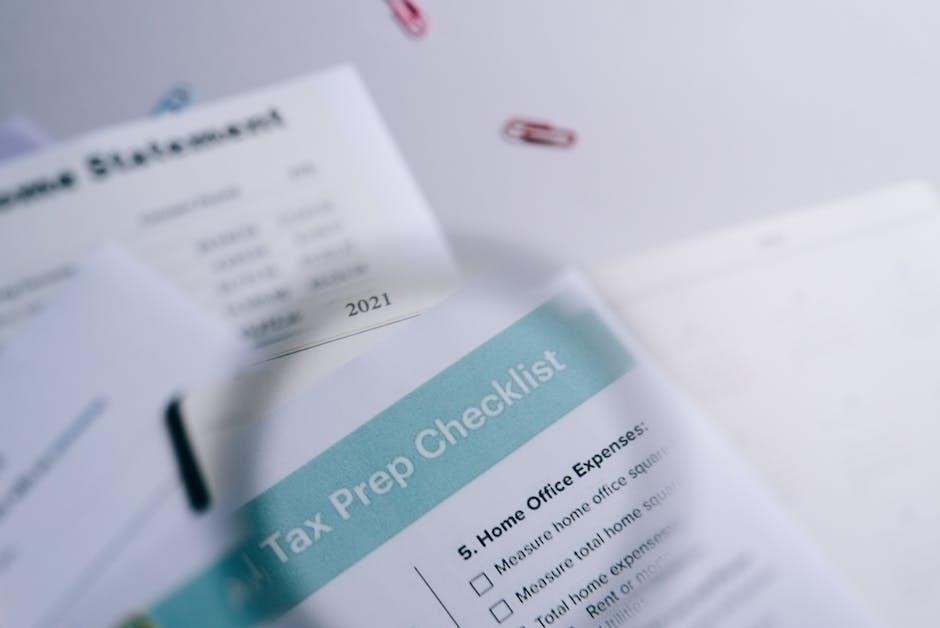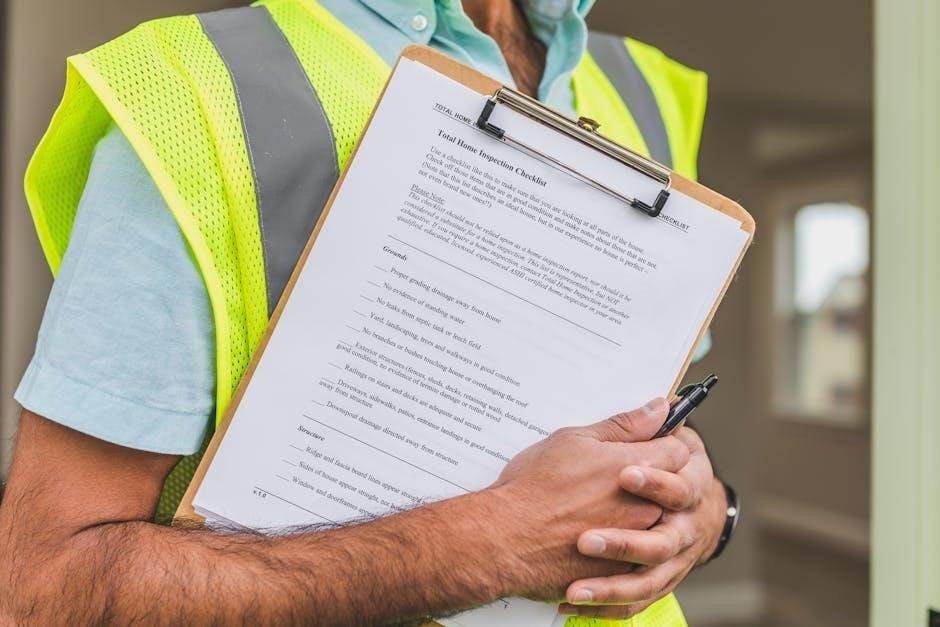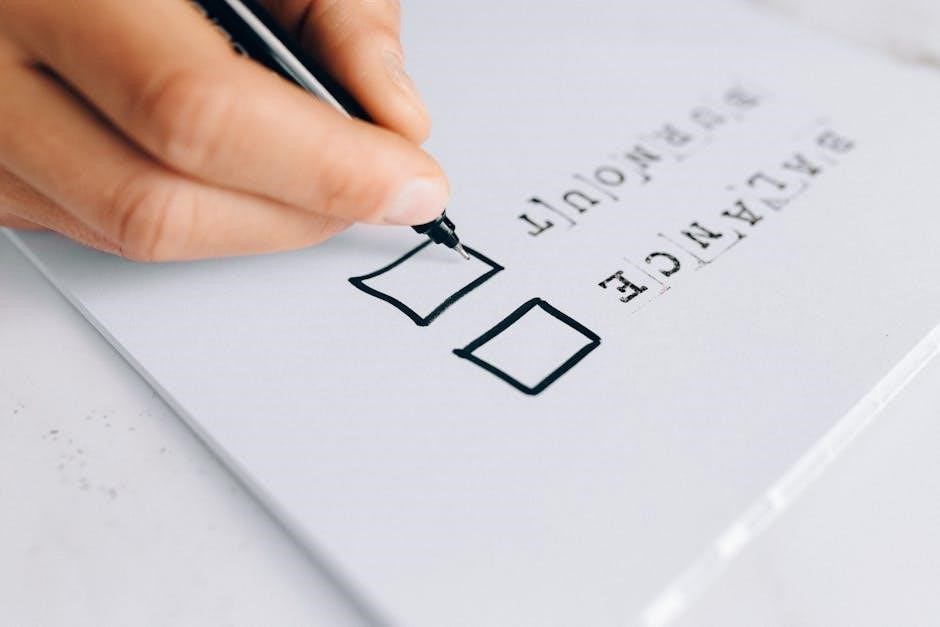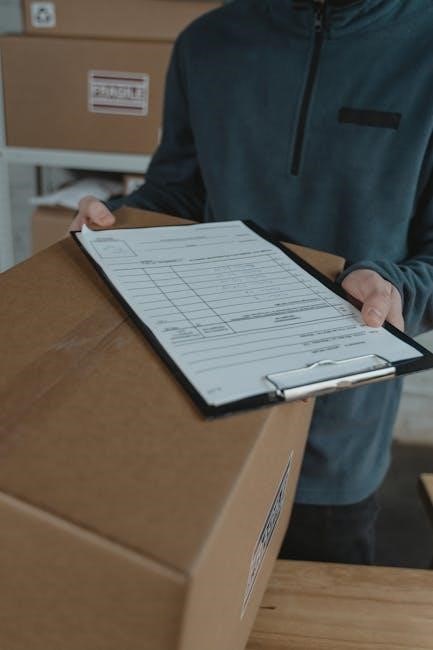
A Prepper Checklist PDF is a comprehensive guide to help families and individuals prepare for emergencies. It organizes essential items and strategies, ensuring readiness for any crisis.

What is a Prepper Checklist?
A Prepper Checklist is a detailed, organized guide designed to help individuals and families prepare for emergencies, disasters, or unexpected events. It typically includes essential items, strategies, and steps to ensure safety and survival.
These checklists often cover food, water, medical supplies, communication tools, and shelter needs. They also address long-term survival skills and strategies for securing home and property.
By breaking down preparation into manageable categories, a Prepper Checklist simplifies the process of readiness. It serves as a roadmap for beginners and experienced preppers alike, ensuring no critical items or plans are overlooked.
Customizable to fit individual circumstances, a Prepper Checklist is a vital tool for anyone seeking to enhance their resilience and peace of mind in uncertain times.
It emphasizes practicality, prioritizing actionable steps over theoretical concepts, making it a cornerstone of effective emergency preparedness.

Why is a Prepper Checklist Important?
A Prepper Checklist is crucial for ensuring readiness during emergencies, offering a structured approach to preparation. It helps avoid panic by organizing essential items and strategies.
By providing a clear guide, it minimizes the risk of oversight, ensuring critical supplies like food, water, and medical gear are readily available. This organization is vital for quick decision-making in high-stress situations.
Customization options allow the checklist to cater to individual or family needs, including specific disaster scenarios or pet provisions. This tailored approach enhances its effectiveness.
Ultimately, a Prepper Checklist fosters a proactive mindset, encouraging preparedness and confidence in the face of uncertainty. It is an indispensable tool for anyone prioritizing safety and resilience.

Essential Items for Your Prepper Checklist
Essential items for your Prepper Checklist include food, water, first aid kits, flashlights, and multi-tools. These supplies ensure basic needs are met during emergencies.
Food and Water Supplies
Stockpiling food and water is critical for survival. Aim for at least one gallon of water per person daily for drinking, cooking, and hygiene. Include non-perishable, high-calorie foods like canned goods, dried fruits, nuts, and MREs. Don’t forget a manual can opener. Rotate supplies every six months to avoid expiration. Consider water purification tablets or filters for safe drinking water. Store food in airtight, pest-proof containers. For cooking, include portable stoves or camping gear. Pack ready-to-eat meals for quick access. Don’t overlook pet food and baby supplies if needed. A well-planned food and water supply ensures sustenance during extended crises. Always check expiration dates and refresh stock as needed.
First Aid and Medical Equipment
A well-stocked first aid kit is vital for treating injuries and preventing infections. Include bandages, antiseptic wipes, pain relievers, and medical gloves. Add prescription medications and essential medical tools like scissors and tweezers. Consider a portable defibrillator for severe emergencies. Don’t forget over-the-counter medications for common ailments. Store all supplies in a waterproof, easily accessible container. Include a first aid manual for guidance on treating wounds and broken bones. Customize the kit based on family needs, such as including pediatric supplies. Regularly check expiration dates of medications and replace as needed. A comprehensive first aid kit ensures you can respond effectively to medical emergencies when professional help is unavailable. Always keep it in your bug-out bag and at home.
Shelter and Sleeping Gear
Shelter is a top priority in any survival situation, providing protection from harsh weather and wildlife. A lightweight, waterproof tent is essential, along with a sturdy tarp for additional coverage. Include a sleeping bag rated for extreme temperatures and a sleeping pad for insulation. Don’t forget extra stakes, ropes, and a mallet for securing your shelter. Consider a portable camping stove and fuel for warmth and cooking. Store a backup tent and emergency blanket in case of damage. For long-term scenarios, include a hammer, nails, and saw for building makeshift shelters. Ensure all gear is durable and easy to assemble. Pack a small toolkit for repairs. Remember to customize your shelter gear based on the environment, such as snow stakes for winter conditions. Always test your equipment before an emergency to ensure it’s reliable and easy to use. Proper shelter can significantly improve your chances of survival.
Communication and Navigation Tools
Effective communication and navigation are critical in emergencies. Include a portable two-way radio for staying in contact with family and allies. A NOAA Weather Radio ensures you receive vital updates during disasters. Add a reliable GPS device for navigation, along with extra batteries. A compass is essential for manual direction-finding. Consider a satellite phone for remote areas with no cellular service. Include a whistle or other signaling device to call for help. Store a detailed map of your region for alternative routes. Don’t forget a solar-powered charger to keep devices operational. Ensure all tools are water-resistant and durable. Teach family members how to use each item. Regularly test equipment to ensure functionality. These tools can help you stay informed, connected, and on course during a crisis. Proper communication and navigation gear are vital for safety and coordination. Always prioritize reliability and ease of use when selecting these items.

Advanced Prepper Strategies
Advanced prepping involves refining survival techniques and adapting to diverse scenarios. It includes creating detailed emergency plans and enhancing self-sufficiency skills, ensuring preparedness for prolonged crises and unexpected challenges.
Building a Bug-Out Bag
A bug-out bag is a portable survival kit designed to sustain you for at least 72 hours. It should include essentials like water (1 gallon per person per day), non-perishable food, a first aid kit, and a multi-tool. Additionally, incorporate a flashlight, extra batteries, and a means of communication, such as a portable radio or a fully charged cell phone. Shelter and warmth are crucial, so add a lightweight tent, a sleeping bag, and a fire-starting tool like matches or a ferro rod. Personal documents, such as ID and insurance cards, should also be included. Customize the bag based on personal needs, including medications and specific gear for children or pets. Regularly update and check the bag to ensure all items are usable and not expired. This preparation ensures readiness for quick evacuations and unexpected situations.
Long-Term Survival Skills
Long-term survival skills are crucial for sustaining life beyond the initial crisis. Mastering water purification techniques, such as filtration or distillation, ensures access to safe drinking water. Food procurement skills, like gardening, hunting, or foraging, provide sustainable nutrition. Shelter construction using natural materials or repurposed items is essential for protection from elements. Fire starting, a fundamental skill, can be achieved with matches, flint, or solar methods. Knowledge of self-defense and conflict resolution is vital for personal safety. Understanding basic first aid, including wound cleaning and herbal remedies, prevents minor injuries from becoming life-threatening. Familiarity with signal techniques, such as using mirrors or smoke, aids in calling for help. Navigation skills, including map reading and compass use, ensure you can find your way. Mental resilience and adaptability are equally important, as prolonged crises demand emotional strength. These skills, when combined, enhance your ability to thrive in challenging environments and recover in the long term.
Securing Your Home and Property
Securing your home and property is a critical aspect of prepping, ensuring safety and protecting your resources. Reinforce doors and windows with sturdy locks and consider installing security systems. Fencing your property can deter intruders, while outdoor lighting enhances visibility. Keep emergency escape routes clear and establish a safe room or panic room for extreme situations. Store valuable supplies in hidden, secure locations to prevent theft. Regularly inspect your property for vulnerabilities and address them promptly. Additionally, maintaining a low profile and avoiding visible displays of wealth can reduce the risk of targeting. Building a strong, cooperative relationship with neighbors can also enhance community security. By implementing these measures, you create a safer environment, safeguarding your family and supplies during crises. This proactive approach is essential for long-term survival and peace of mind. Stay vigilant and adapt your security strategies as needed to address potential threats effectively.

Specialized Prepper Checklists
Specialized prepper checklists cater to unique scenarios, such as urban vs. rural settings, disaster-specific needs, and family or pet requirements. They ensure preparedness for diverse challenges and environments effectively.
Prepping for Specific Disasters

Prepping for specific disasters requires tailored strategies to address unique challenges. For example, earthquake preparedness includes securing heavy furniture and having an emergency exit plan. Hurricane prepping involves boarding up windows and stockpiling flood protection supplies. Wildfire preparedness focuses on creating defensible spaces and having fire-resistant materials. Flood prepping emphasizes waterproof storage and elevated essentials. Tornado prepping includes building a storm shelter or identifying safe rooms. Each disaster type demands distinct gear and plans, ensuring readiness for location-specific risks. Understanding regional threats and customizing checklists accordingly is crucial. Personalized disaster plans, including evacuation routes and communication strategies, enhance safety. Regular drills and updates to supplies ensure long-term preparedness. By focusing on disaster-specific needs, preppers can mitigate risks effectively and respond confidently when crises arise.
Prepping in Urban vs. Rural Areas
Prepping in urban and rural areas differs significantly due to varying challenges and resource availability. Urban prepping focuses on mobility, stealth, and accessing limited resources. Bug-out bags are essential for quick evacuations, while rural prepping emphasizes long-term sustainability. Urban areas require strategies for navigating crowded spaces and securing supplies in tight quarters, while rural settings allow for more space to stockpile goods and implement alternative energy solutions. Urban preppers often prioritize self-defense and communication tools, as help may be farther away. Rural preppers, however, can focus on farming, water collection, and renewable energy systems. Both environments demand tailored checklists, but urban prepping often involves more community reliance, while rural prepping focuses on self-sufficiency. Understanding these differences ensures effective preparation for location-specific challenges. Adaptability and situational awareness are key to thriving in either setting.

Prepping for Families and Pets
Prepping for families and pets involves creating a tailored plan to ensure everyone’s safety and comfort during emergencies. Families with children need age-appropriate supplies, such as diapers, formula, and educational toys, to maintain morale. Pets require their own emergency kits, including food, water, leashes, and medications. Communication is crucial; family members should know emergency contact points and meeting locations. Involving children in preparedness can reduce anxiety and teach valuable skills. Pets may need carriers or specific gear for mobility. A family checklist should account for varied needs, ensuring no one is overlooked. Regular drills and discussions help prepare everyone mentally and practically. Customizing plans for each family member and pet ensures a united and resilient response to crises.